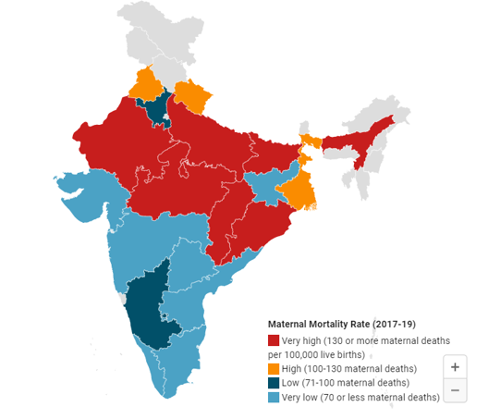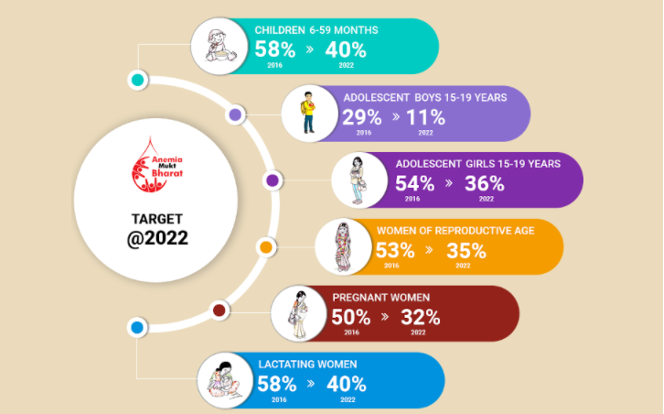Maternal Mortality Rate (MMR) is defined as the number of maternal deaths per 100,000 live births due to pregnancy or termination of pregnancy, regardless of the site or duration of pregnancy. The maternal mortality rate is used to represent the risk associated with pregnancy among women.
Aspirants would find this article very helpful while preparing for the IAS Exam.
Maternal Mortality Rate:- Download PDF Here
| Aspirants should begin their preparation by solving UPSC Previous Year Question Papers now!!
To complement your preparation for the upcoming exam, check the following links: |
In developing countries, the leading cause of death and disability among women of reproductive age are the complications that occur during childbirth and pregnancy.
Maternal Mortality Rate in India
In India, the number of deaths caused due to pregnancy and childbirth has been very high over the years but recent records show that there has been a decline in the MMR of India. It is tough to calculate the exact maternal mortality except where the comprehensive records of deaths and causes of death are available. So surveys and census are used to estimate the levels of maternal mortality.
Reproductive Age Mortality Studies (RAMOS) is presently considered the best way to calculate MMR. In this, different sources and records are analysed to get data regarding the death of women of reproductive ages and also through verbal autopsy to estimate the number of deaths. The MMR is calculated at both global and regional level every five years through a regression model.
In India, the Sample Registration Survey (SRS) is used to get an estimate of the maternal mortality rate. The Office of the Registrar General’s Sample Registration System (SRS) has released a special bulletin on Maternal Mortality in India in March 2022.
Major observations as per the Survey –
- As per the special bulletin there has been a decline of 10 points in the maternal mortality rate of India. India’s maternal mortality ratio (MMR) has improved to 103 in 2017-19, from 113 in 2016-18, marking an 8.8% decline.
- This is in sync with the trend of progressive reduction in the MMR over the years. With this persistent decline, India is on the verge of achieving the National Health Policy (NHP) target of 100/lakh live births by 2020 and certainly on track to achieve the Sustainable Development Goal (SDG) target of 70/ lakh live births by 2030
- Currently seven states have achieved the Sustainable Development Goal (3.1) target. This marks an improvement compared to last survey when only five states had reached the target. Currently these states include Kerala (30), Maharashtra (38), Telangana (56), Tamil Nadu (58), Andhra Pradesh (58), Jharkhand (61), and Gujarat (70).
- Currently there are nine States that have achieved the MMR target set by the National Health Policy. This includes the above seven states along with Karnataka (83) and Haryana (96).
- Despite an improvement in the national average, some states continue to witness high levels of maternal mortality rates.
| Definition | States | |
| Very high maternal mortality | 130 or more maternal deaths per 100,000 live births. | Bihar (130), Odisha (136), Rajasthan (141), Chhattisgarh (160), Madhya Pradesh (163), Uttar Pradesh (167) and Assam (205). |
| High maternal mortality: | 100-130 maternal deaths per 100,000 live births. | Uttarakhand (101), West Bengal (109) and Punjab (114). |
| Low maternal mortality: | 71-100 maternal deaths per 100,000 live births. | Karnataka (83) and Haryana (96). |
- The states of Uttar Pradesh, Rajasthan and Bihar have seen the most drop in MMR in absolute numbers. These states continue to have high level MMRs despite the improvement.
- Uttar Pradesh reported a decline of 30 points, Rajasthan (23 points) and Bihar (19 points).
- A remarkable fall of more than 15 percent has been observed in the states of Kerala, Maharashtra and Uttar Pradesh.
- The top state with the lowest MMR is Kerala while the state with the highest MMR is Assam.
- Notably states like West Bengal, Haryana, Uttarakhand and Chhattisgarh have recorded an increase in MMR over the last survey in contrast to the national trend.

Given below is the MMR in India as per the Sample Registration System:
| Maternal Mortality Rate (MMR) in India | |
| Year | MMR |
| 2004-2006 | 254 |
| 2007-2009 | 212 |
| 2010-2012 | 178 |
| 2011-2013 | 167 |
| 2014-2016 | 130 |
| 2015-2017 | 122 |
| 2016-2018 | 113 |
| 2017-2019 | 103 |
The above data clearly shows the decline in the trend of maternal mortality rate in India. In the survey conducted in 2015-2017, Kerala was the state with the least maternal mortality rate of 42 and Assam noted the maximum number of deaths of women in India with MMR of 229.
Candidates can refer to the UPSC Mains GS 1 Syllabus, Structure, from the linked article.
Causes of High Maternal Mortality Rate
There are various reasons for the death of women during their reproductive age (18 to 39 years)that had been the cause of an increase in the maternal mortality rate. Given below are a few reasons for the rate of deaths of women due to pregnancy and childbirth:
- Spread of diseases
- Unawareness
- Lack of nutrition and unhealthy livelihood
- Haemorrhage
- Incorrect Treatment
Studies have shown that most deaths during pregnancy and childbirth are curable and can be controlled if proper treatment is provided to women. It has also been noted that calculating the exact MMR is not possible as multiple records of deaths are not recorded for reasons like abortion, ill-treatment and lack of medical attribution.
Result of MDG and SDG with respect to Maternal Mortality Rate
The Millennium Development Goals were set UNDP for all the member nations of the UN. MDG was a set of eight goals that were set for a better future of the world and the people living in it. The Sustainable development goals were undertaken by the members of the UN after a fifteen-year successful plan of the MDG.
The Millennium Development goals were successful in reducing poverty and infant mortality rate almost half since 1990. The latest report of Sustainable development goals released for 2019 has stated that a major decline in the number of deaths caused due to pregnancy and childbirth has been noted across the world.
The report also states that between 2015 and 2018, there has been an increase of 81 per cent assistance provided to pregnant ladies and that has been one of the major reasons for the decline in MMR. In 2018, the report released by SDG stated a decline of 37 per cent in the maternal mortality rate since 2000.
The sustainable development goals intend to attain their target of 70 deaths per 100,000 by 2030 with respect to the maternal mortality rate. Many actions have been taken for a better livelihood and proper assistance is being provided to reproductive women and awareness is being spread with an intention to end the maternal mortality rate across the world.
Maternal Mortality Rate in India – Reasons for Decline
The following programs implemented by the government is playing a crucial role in reducing the Maternal Mortality Rate in India.
Anaemia Mukt Bharat (AMB)
- Anaemia Mukt Bharat (AMB) strategy was launched in 2018 with the objective of reducing anaemia prevalence among children, adolescents and women in the reproductive age group.
- It focusses on six target beneficiary groups, through six interventions and six institutional mechanisms to achieve the envisaged target under the POSHAN Abhiyan.

- The 6 interventions include supply of iron and folic acid supplements, deworming, behaviour change communication campaign, testing for anaemia, provision of iron and folic acid fortified foods in government-funded health programmes and addressing of non-nutritional causes of anaemia in endemic pockets with a special focus on malaria and fluorosis.
More on Anaemia Mukt Bharat in the link.
Surakshit Matratva Ashwasan (SUMAN):
- The Surakshit Matritva Aashwasan (SUMAN) has been launched by the Ministry of Health and Family Welfare in 2019.
- It aims to provide assured, dignified and respectful delivery of quality healthcare services at no cost and zero tolerance for denial of services to any woman and newborn visiting a public health facility in order to end all preventable maternal and newborn deaths and morbidities and provide a positive birthing experience.
- Under the scheme, all pregnant women, newborns and mothers up to 6 months of delivery will be able to avail of several free health care services such as four antenatal check-ups and six home-based newborn care visits.
Anmol app:
- It is a multifaceted mobile tablet-based android application of the Ministry of Health & Family Welfare (MoHFW) for early identification and tracking of the individual beneficiary.
- The application would help to ensure tracking of beneficiaries for proper health care and promote family planning methods being adopted by them. The system also facilitates to ensure timely delivery of full competence of antenatal, postnatal & delivery services and tracking of children for complete immunization services.
LaQshya – Labour Room Quality Improvement Initiative
- This program focuses on Public Health facilities to help. They will be assisted by helping them improve their maternity operation theatres, and help augment the quality of care in labour rooms.
- This program will be implemented in all Community Health Centres (CHC), First Referral Unit (FRU), District Hospitals, Medical College Hospitals.
Pradhan Mantri Matru Vandana Yojana (PMMVY)
- Pradhan Mantri Matru Vandana Yojana (PMMVY) is implemented by the Ministry of Women and Child Development.
- PMMKVY came into effect from 1st January 2017.
- This Maternity Benefit Program is implemented in all districts.
- On fulfilling certain conditions, the beneficiaries would receive Rs 5,000 in 3 instalments.
- Cash benefits would be directly transferred to the bank accounts of the beneficiaries.
- Pradhan Mantri Matru Vandana Yojana – Common Application Software (PMMVY – CAS) is used for monitoring this program.
Janani Suraksha Yojana (JSY)
- This scheme is completely sponsored by the Government of India.
- Janani Suraksha Yojana comes under the National Health Mission.
Pradhan Mantri Surakshit Matritva Abhiyan (PMSMA)
- This program was launched with the objective of detecting and treating cases of anaemia.
Candidates can refer to the Previous Year’s Governance Questions in UPSC Mains GS 2, from the linked article.
Maternal Mortality Rate:- Download PDF Here
The above details would help candidates prepare for UPSC 2023.
Related Links
| IAS Salary | UPSC Syllabus |
| What is IES | Which is the Largest Lake in India |
| Six Fundamental Rights | Tiger Reserves in India Map |
| Monthly Current Affairs Quiz | Importance of Indian Constitution |
Frequently Asked Question MMR
Q1. What is the difference between Maternal Mortality Rate and Maternal Mortality Ratio?
Ans. Maternal Mortality Rate is defined by the World Health Organization (WHO) as “the death of a woman while pregnant or within 42 days of termination of pregnancy, irrespective of the duration and site of the pregnancy, from any cause related to or aggravated by the pregnancy or its management but not from accidental or incidental causes.
Maternal Mortality Ratio is the annual number of female deaths per 100,000 live births from any cause related to or aggravated by the pregnancy or its management (excluding accidental or incidental causes). The maternal mortality ratio is a key performance indicator for efforts to improve the health and safety of mothers before, during, and after childbirth per country worldwide
Q 2. What are the reasons for the high maternal mortality rate?
Ans. Given below are a few causes for the high maternal mortality rate:
- Unawareness
- Unhealthy livelihood
- Unhygienic surroundings
- Incorrect Treatment
- Spread of diseases
- Haemorrhage
Comments